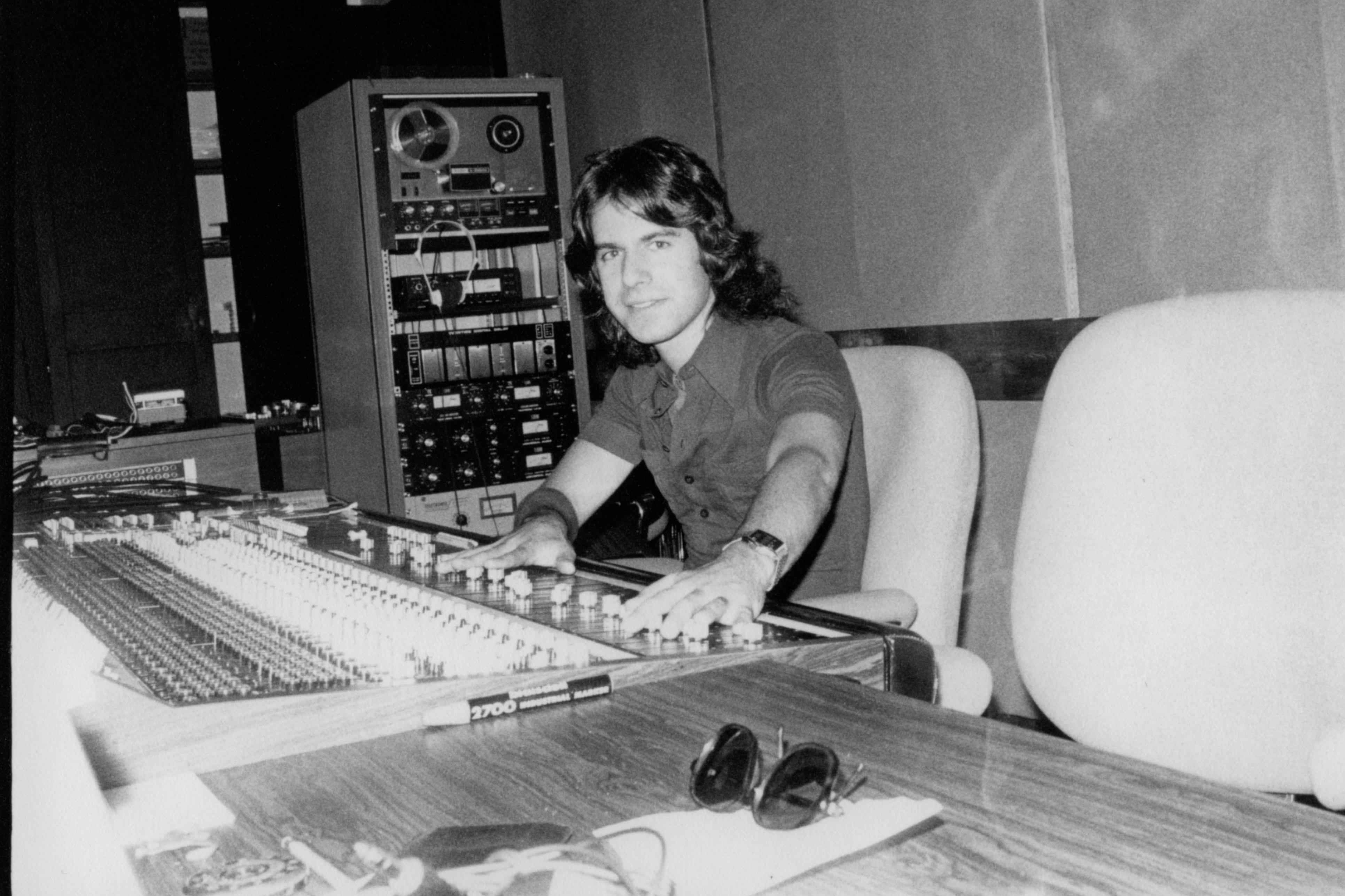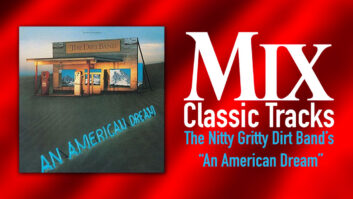 A view from the Plaza Sound control room into the live room
A view from the Plaza Sound control room into the live room“From the minute they started playing, I was thinking, ‘I know this song,’” recalls engineer/producer Rob Freeman. He was behind the board at Plaza Sound Studios for Richard Gottehrer’s production of the first two albums by then-up-and-coming band Blondie.
The track he’s referring to is “Denis,” or “Denise,” a Neil Levenson-penned song that had been a Top 10 hit for doo-wop group Randy & The Rainbows in 1963 before Blondie covered it. Before the melody was even apparent, Freeman recognized a key element of the arrangement that the two versions share: that strumming, drum-rolling intro that owes much to Buddy Holly’s “Peggy Sue.”
Blondie included “Denis” on the album Plastic Letters, in the great punk tradition of honoring the beauty and romance of early rock ’n’ roll, even while offering up songs such as “Youth Nabbed as Sniper,” “Kidnapper” and “I’m on E.”
Plastic Letters was the second LP that the band made in Plaza Sound, New York City, with Gottehrer and Freeman. Their eponymous debut came in 1976, and Freeman remembers those early sessions as a time of discovery for the musicians.
“Recording in a professional studio like Plaza Sound was something new for them, and it created a sense of joy and wonder,” Freeman says. “It was like, ‘Holy cow, that’s us coming out of the speakers! Listen to that!’ They were excited about what they were doing, and they incorporated all kinds of things they’d heard into their music. It could have been Japanese anime background music or a cornflake commercial that influenced a song, or a keyboard or guitar part. Their sources of influences were wide open.”
Freeman points out that the studio itself, with its illustrious history and grand space, was another source of inspiration. “Plaza was built in the ’30s by NBC as a rehearsal studio for Toscanini and his orchestra, and was later used as a broadcast studio,” the engineer explains. “It cost over half a million dollars—a ton of money back then—to build that huge, orchestral room with its wonderful, nicely controlled acoustics. Plaza was quite unique!
 Rob Freeman at the API console in Plaza Sound
Rob Freeman at the API console in Plaza Sound“Plaza Sound had a certain vibe,” Freeman continues. “Even just getting up to the studio was an interesting experience. The studio was located on the sixth floor, above Radio City Music Hall. You entered the building from either of the side streets, 50th or 51st Street. Then you went up a special elevator, through unmarked doorways, and climbed a flight of stairs before winding through a labyrinth of hallways, all painted battleship gray. It was a weird, cloak-and-daggerish route. It was part of Plaza’s charm, and it felt special. Bands seemed to love how tucked away it was.”
Freeman points out that the suspended, room-within-a-room studio design no doubt contributed to the high cost of building the facility, which, as noted, shared walls and halls with Radio City. “The entire sixth floor was suspended on cork and steel springs,” he says. “The Rockettes rehearsed up there, and their hundreds of feet dancing would make a thunderous sound. For that reason, they acoustically isolated the sixth floor from the rest of the building.”
Blondie: Still Dreaming
By the time Blondie began recording their first album at Plaza Sound, the studio was reasonably well-equipped for music projects, and that was at least partly due to Freeman’s efforts. When he joined the Plaza Sound staff in 1974 as head engineer, the studio worked on industrial and commercial projects mainly via an 8-track Scully machine and a Spectrasonics console.
“Being a musician, I thought, ‘What can I do to bring in the technology and the ability to make records?’” Freeman recalls. “The studio had plenty to offer: There was a 9-foot concert grand Steinway, a built-in Wurlitzer pipe organ with three separate pipe chambers, orchestral instruments such as tympanis, tubular chimes and glockenspiel, as well as a wide array of vintage microphones—many with their original tube power supplies. The mic closet was a joy to behold. The studio had all these great features but just wasn’t doing the right kinds of projects. So I kept chipping away, saying, ‘Let’s get some proper equipment in here and make records!’”
During Freeman’s first two years, studio owner Gregg Raffa did make many key changes, including upgrading to a 16-track 3M Isoloop tape machine and installing a 32-input API console, the first in New York City.
“Our console acted as a demo board, so to speak, for API, who wanted to showcase their new line of consoles in a functioning studio,” Freeman says. “Folks from API would come around every so often, bringing people through and saying, ‘Check out our beautiful board in this spectacular room.’”
The members of Blondie—singer Debbie Harry, guitarist Chris Stein, keyboardist Jimmy Destri, drummer Clem Burke and new bass player Frank Infante (replacing Gary Valentine)—were seasoned and rehearsed when they came in to record their sophomore album, after playing numerous gigs behind the first record and then spending several days in a rehearsal space finalizing the Plastic Letters arrangements with Gottehrer. Freeman remembers the sessions as being fun but more businesslike than the first album. The studio setup, however, was very similar to what had been used on their debut.

“If a band came in and we wanted the whole room to be open acoustically, we could do that,” Freeman says. “But for more separation and control, I would often divide the room in half, and that’s what I did with Blondie. Plaza had a number of large rolling baffles that were 8 or 9 feet tall and about 8 inches thick. Some had windows. I’d roll them in to divide the 100-foot-long room literally in half, putting two baffles tightly together, leaving a little space to walk through, then two more and two more, all the way across the 65-foot width of the room.”
Bisecting the space gave Freeman more control over the room acoustics, as did Harry’s preference to sing live in a booth, in the room while the band tracked.
Classic Tracks: Blondie’s “The Tide Is High”
“There was a huge rolling vocal booth,” Freeman recalls. “It had glass panels for isolation and a sound-locking door in the back; it was really heavy and took at least two people to move it around. Debbie liked to sing in that booth with no lights on. I had her sing into a [Neumann] tube U47. Singing with the band while they recorded basic tracks, Debbie might have assumed she was just providing scratch vocals, but many of those performances became finished vocals, with a only few tweaks later on.”
The rest of the musicians played together in the half-studio, with amplifiers individually baffled. Infante’s bass was split between an amp and a DI. Destri’s keyboards were also taken direct; everything else was miked up.
“The drum kit was set up fairly close to the control room glass for added liveliness,” Freeman explains. “I believe we recorded drums on five tracks: bass drum blanketed with an AKG D12 placed inside, snare drum with a Sennheiser 421 on top, hi-hat with a Neumann KM56 pencil mic, and overheads left and right were two Neumann U87s to capture the tom-toms and cymbals. At Plaza Sound, I often recorded drums with room mics, like AKG C12s, placed 20 to 30 feet away from the kit, as well, upping the number of drum tracks to seven. But having listened to ‘Denis’ recently, I didn’t hear the open sound of room mics so much as just that wonderful, natural drum sound coming from a combination of close mics and overheads. It does sound like we might have doubled the snare and some tom fills in places.”
Infante’s bass mic was an Electro-Voice RE20, and Stein’s guitars were captured by a Shure SM57 and a Neumann U87. “The dynamic mic would be placed right up close to the cone of the speaker, and the condenser mic, with a -10 dB pad in, would be about 2 to 3 feet back,” Freeman says. “As we were doing overdubs later, I would move the U87 8 to 10 feet away from the amp because we weren’t worried about drum leakage at that point.”
Freeman also employed the studio’s collection of “now-vintage” outboard gear during tracking: Teletronix LA-2A tube compressor/limiters, Pultec tube EQs and more. “We had a wealth of Pultecs—three or four different types—and several of those classic LA-2A compressors, and I just used them like crazy,” he recalls.
Classic Tracks: The Go-Go’s “Our Lips Are Sealed,”
“‘Denis’ sounded like a hit from the minute they started playing it,” Freeman says. “Debbie’s voice was bubbly, and she sang the song really well and sounded great. Her voice cut right through the rhythm tracks. She had that little growl that would come in every now and then.”
Harry also played with the lyrics of the song. The band had changed their version from “Denise” to “Denis,” French for Dennis, so that Harry could sing “You’re my king” and “I’m so lucky ’cause I found a boy like you” in French, in one of the verses toward the end of the song.
“When we came to the point where we had the solid track and a great vocal, that’s when Richard would put on his final touches,” Freeman says. “It was often Richard’s layer of percussion that made a track sound truly finished. He brought in a huge bag of tambourines, shakers, and some African instruments. That song also had some foot stomps added.
“Those percussion sessions were the capper, and always great for me, too, because I loved getting out of the control room to play in the studio after setting things up,” he reminisces. “I’d have my assistant hit the record button, and I would become one of the musicians, shaking a tambourine or shaker, clapping hands or stomping feet along with the band. That percussion really made the record sound like a hit. It gave it a timeless sound.”
“Denis” was the first single that Blondie released from Plastic Letters in 1978, and it was a massive hit in Europe: a Number 2 song from a Top 10 album in the UK, Number One in Belgium and The Netherlands, and a Top 20 song in several other countries.
“Denis” didn’t chart in the U.S.; Americans don’t always share Europeans’ love for old-school rock ’n’ roll. But Plastic Letters was a Top 100 album, and the video for “Denis,” with the exceptionally beautiful Harry dancing in what looks like a sweater over a swim suit, captured viewers’ attention and primed them for Blondie’s biggest successes to come.












